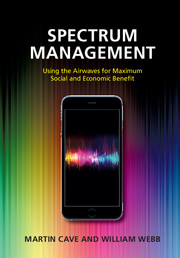Book contents
- Frontmatter
- Contents
- Preface
- Acknowledgments
- Plan of the book
- List of abbreviations
- Part I Fundamentals
- Part II Economic management of spectrum
- 4 Using auctions to assign spectrum
- 5 Other aspects of spectrum auction design
- 6 Spectrum trading
- 7 Spectrum pricing and valuation
- Part III Sharing and other emerging approaches to spectrum management
- Part IV Case studies and conclusions
- About the authors
- Index
- References
4 - Using auctions to assign spectrum
from Part II - Economic management of spectrum
Published online by Cambridge University Press: 05 November 2015
- Frontmatter
- Contents
- Preface
- Acknowledgments
- Plan of the book
- List of abbreviations
- Part I Fundamentals
- Part II Economic management of spectrum
- 4 Using auctions to assign spectrum
- 5 Other aspects of spectrum auction design
- 6 Spectrum trading
- 7 Spectrum pricing and valuation
- Part III Sharing and other emerging approaches to spectrum management
- Part IV Case studies and conclusions
- About the authors
- Index
- References
Summary
Introduction
In economics, auctions form a part of a field of study more generally known as mechanism design. As Hurwicz and Reiter [1, p. 30] explain, “in a design problem, the goal function is the main ‘given,’ while the mechanism is the unknown. Therefore, the design problem is the ‘inverse’ of traditional economic theory, which is typically devoted to the analysis of the performance of a given mechanism.” In designing an auction the spectrum manager exercises a degree of discretion in pursuit of the chosen goals. This chapter discusses the properties of different types of auction design. Useful general accounts of auctions can be found in [2, 3]; on spectrum auction design see especially [4].
While the use of auctions to assign licenses is now the default position for most major spectrum award processes worldwide, before 1989 this was not the case. To understand why auctions have become so prevalent, it is useful to examine deficiencies in other processes. This is done in Section 4.3.
Some types and effects of auctions
An item up for auction can be described as having either private-value characteristics or common-value characteristics. This distinction can matter fundamentally.
In a private-value auction each bidder values an item by reference to the value it confers through consumption. For example, in deciding how much to bid for a family heirloom, a person is likely to be guided by sentimental rather than financial considerations. There is no reason why one person's valuation should be the same as another's.
By contrast, a common-value auction typically involves items that are not exclusively or chiefly used for final consumption. The key characteristic of an item in a common-value auction is that all bidders would agree on the valuation if they possessed the same objective information about the item. A good example would be a tract of land made available for drilling rights to extract oil. If all parties interested in the tract were given the same geophysical data, were to use the same extraction techniques, and estimated the same futures prices for oil, then they would each have the same belief about the valuation – in other words the valuation would be common to all bidders [5].
- Type
- Chapter
- Information
- Spectrum ManagementUsing the Airwaves for Maximum Social and Economic Benefit, pp. 63 - 93Publisher: Cambridge University PressPrint publication year: 2015



